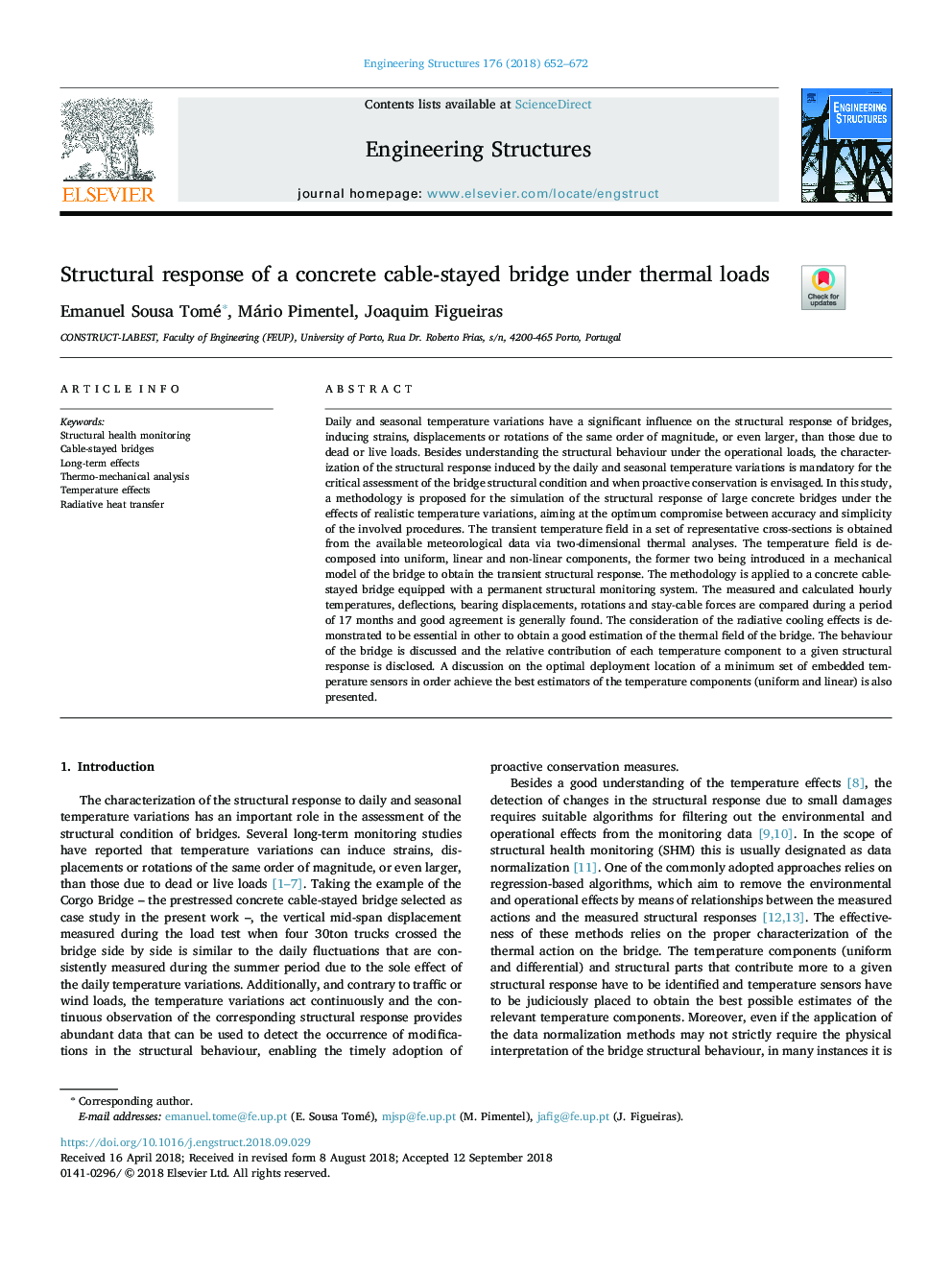| کد مقاله | کد نشریه | سال انتشار | مقاله انگلیسی | نسخه تمام متن |
|---|---|---|---|---|
| 11028925 | 1646695 | 2018 | 21 صفحه PDF | دانلود رایگان |
عنوان انگلیسی مقاله ISI
Structural response of a concrete cable-stayed bridge under thermal loads
ترجمه فارسی عنوان
پاسخ ساختاری یک پل مجهز به سیم بتونی تحت بارهای حرارتی
دانلود مقاله + سفارش ترجمه
دانلود مقاله ISI انگلیسی
رایگان برای ایرانیان
کلمات کلیدی
نظارت بر سلامت سازمانی، پل های ممانعت کننده کابل، اثرات بلند مدت، تجزیه و تحلیل حرارتی مکانیکی، اثرات دما، انتقال حرارت شعاعی،
ترجمه چکیده
تغییرات دما روزانه و فصلی تأثیر قابل ملاحظه ای بر پاسخ ساختاری پل ها، سویه ها، جابجایی ها یا چرخش های مرتبه ی مشابه یا حتی بزرگتر نسبت به بارهای مرده یا زنده دارند. علاوه بر درک رفتار ساختاری در بارهای عملیاتی، مشخصه واکنش ساختاری ناشی از تغییرات دمای روزانه و فصلی برای ارزیابی بحرانی وضعیت ساختاری پل و زمانی که پیش بینی حفاظتی پیش بینی شده است، اجباری است. در این مطالعه یک روش برای شبیه سازی پاسخ ساختاری پل های بتنی بزرگ تحت تاثیر تغییرات دما واقع بینانه، با هدف سازش بهینه بین دقت و سادگی روش های درگیر انجام شده است. فیلد دمای متغیر در مجموعه ای از مقاطع نماینده از داده های هواشناسی در دسترس از طریق تجزیه و تحلیل های حرارتی دو بعدی بدست می آید. فیلد دما به اجزاء یکنواخت، خطی و غیر خطی تجزیه می شود، که دو سابق در یک مدل مکانیکی پل برای به دست آوردن پاسخ ساختاری گذرا ارائه می شوند. این روش برای یک پل متصل به سیم بتنی مجهز به سیستم نظارت ساختاری دائمی است. دمای ساعت اندازه گیری شده و محاسبه شده، انحراف، تحرک جابجایی، چرخش و نیروی باقی ماندن در طول 17 ماه با هم مقایسه می شود و هماهنگی خوبی به دست می آید. در نظر گرفتن اثرات خنک کننده شعاعی در سایر موارد برای دستیابی به تخمین خوبی از میدان حرارتی پل ضروری است. رفتار پل مورد بحث قرار گرفته و سهم نسبی هر مولفه دما به یک پاسخ ساختاری داده شده افشا شده است. بحث در مورد مکان بهینه سازی نصب حداقل مجموعه ای از سنسورهای دما جاسازی شده به منظور دستیابی به بهترین برآوردگرهای اجزای دما (یکنواخت و خطی) نیز ارائه شده است.
موضوعات مرتبط
مهندسی و علوم پایه
علوم زمین و سیارات
مهندسی ژئوتکنیک و زمین شناسی مهندسی
چکیده انگلیسی
Daily and seasonal temperature variations have a significant influence on the structural response of bridges, inducing strains, displacements or rotations of the same order of magnitude, or even larger, than those due to dead or live loads. Besides understanding the structural behaviour under the operational loads, the characterization of the structural response induced by the daily and seasonal temperature variations is mandatory for the critical assessment of the bridge structural condition and when proactive conservation is envisaged. In this study, a methodology is proposed for the simulation of the structural response of large concrete bridges under the effects of realistic temperature variations, aiming at the optimum compromise between accuracy and simplicity of the involved procedures. The transient temperature field in a set of representative cross-sections is obtained from the available meteorological data via two-dimensional thermal analyses. The temperature field is decomposed into uniform, linear and non-linear components, the former two being introduced in a mechanical model of the bridge to obtain the transient structural response. The methodology is applied to a concrete cable-stayed bridge equipped with a permanent structural monitoring system. The measured and calculated hourly temperatures, deflections, bearing displacements, rotations and stay-cable forces are compared during a period of 17 months and good agreement is generally found. The consideration of the radiative cooling effects is demonstrated to be essential in other to obtain a good estimation of the thermal field of the bridge. The behaviour of the bridge is discussed and the relative contribution of each temperature component to a given structural response is disclosed. A discussion on the optimal deployment location of a minimum set of embedded temperature sensors in order achieve the best estimators of the temperature components (uniform and linear) is also presented.
ناشر
Database: Elsevier - ScienceDirect (ساینس دایرکت)
Journal: Engineering Structures - Volume 176, 1 December 2018, Pages 652-672
Journal: Engineering Structures - Volume 176, 1 December 2018, Pages 652-672
نویسندگان
Emanuel Sousa Tomé, Mário Pimentel, Joaquim Figueiras,
